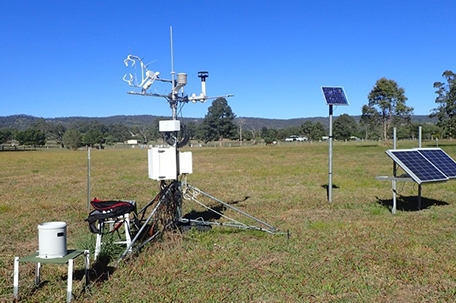A recently released study using TERN is calling attention to the remarkably protective role forests and wetlands play in lessening the impacts of extreme weather on natural and modified landscapes. The landscape research uses an innovative new method to measure the ability of different vegetation types across global biomes to buffer temperature extremes. The method also provides managers with a tool to evaluate the threat to biodiversity of such extremes.
Extreme thermal events are likely to affect ecosystems more dramatically and rapidly than slow increases in mean temperature, so there’s an urgent need to better understand the interactions between vegetation and local weather extremes—and, in turn, what that means for biodiversity and carbon budgets.
Thanks to TERN infrastructure, FAIR data now exist to investigate a number of aspects regarding the impact of extreme weather events, in particular heatwaves, on global ecosystems and their biodiversity, and a team of researchers is on the case.
Lead researcher Dr Hua Lin of the Chinese Academy of Sciences says that everything, ranging from the roughness of a plant’s leaves and the rates of evapotranspiration, through to albedo, heat capacity and the exchange of greenhouse gases and organic compounds, impacts vegetation’s ability to buffer extreme temperatures—called thermal buffer ability or TBA.
“In some cases, maintaining a stable environment is more important than the mean temperature for the organisms, especially under extreme events.
Vegetation with a better buffering ability, a higher TBA, will experience lower extreme temperatures that may protect organisms and prolong the time they need to adapt to a changing climate.
However, until now, there hasn’t been a systematic study of the thermal buffer ability of different vegetation types, including forests, wetlands, grasslands and croplands, across global biomes.”
Dr Hua Lin, Chinese Academy of Sciences

Distribution of the ecosystem monitoring sites used in the study. Vegetation types were classified according to International Geosphere-Biosphere Programme (IGBP). CRO, croplands; DBF, deciduous broadleaf forests; EBF, evergreen broadleaf forests; ENF, evergreen needleleaf forests; GRA, grasslands; MF, mixed forests; OSH, open shrublands; SAV, savannas; WET, permanent wetlands; WSA, woody savannas. (Courtesy Lin et al, 2020).
Forests and wetlands are best at diminishing extreme event impacts
Dr Lin, together with researchers from around the world, filled this major knowledge gap using an innovative new method to compare ten vegetation types across 133 sites around the world.
Long-term micrometeorological time-series data from 22 TERN-supported OzFlux environmental monitoring sites, including 11 TERN SuperSites, were used in the study.
“The results indicate that forests and wetlands buffer thermal fluctuations significantly better than non-forest vegetation types such as grasslands, savannas, and croplands.
Notably, we also found that seriously disturbed and young planted forests displayed a greatly reduced TBA as low as that of non-forests, with the height of a forest’s canopy being the primary controller of TBA in forests. A forest’s TBA value can be used as an indicator of degradation.”
Dr Hua Lin, Chinese Academy of Sciences
Energy partitioning, water availability and CO2 sequestration rates were found to be the main drivers of buffering in non-forests ecosystems.

The thermal buffer ability (TBA) of different vegetation types (courtesy Lin et al, 2020)
Help evaluate the risk of plants and animals to extreme events
The findings warn that forest degradation and deforestation reduce the ability of global ecosystems to buffer temperate extremes, especially under a changing climate. As such, the study points to the critical need to protect mature forests, both at high and low latitudes, to mitigate thermal fluctuation under extreme climatic events.
Professor Jason Beringer of the University of Western Australia and OzFlux Director says the study suggests that reliable estimates of TBA globally will help land managers evaluate the threat extreme events pose to plants and animals in particular areas.
“The study demonstrates that forests are an important climate buffer and therefore degradation or deforestation will reduce this buffering capacity. In addition, reforestation and urban green space can offer improved buffering capacity. Land managers can track those important vegetation types that have high TBA via global monitoring of TBA.
For example, protecting high TBA vegetation would provide thermal buffering for plants and animals and mitigate some of the impacts of climate change.
Conversely, TBA data would also help identify areas at risk so that appropriate management actions could be taken.”
Professor Jason Beringer, University of Western Australia and OzFlux Director
Long-term micrometeorological time-series data from 22 TERN-supported OzFlux environmental monitoring sites, including 11 TERN SuperSites, were used in the study. Data collected by TERN from a variety of ecosystem types, including forests, woodlands (e.g. TERN’s Boyagin Wandoo Wooodland SuperSite (left)) and grasslands (e.g. TERN’s Samford Peri-Urban SuperSite (right)) were used.









